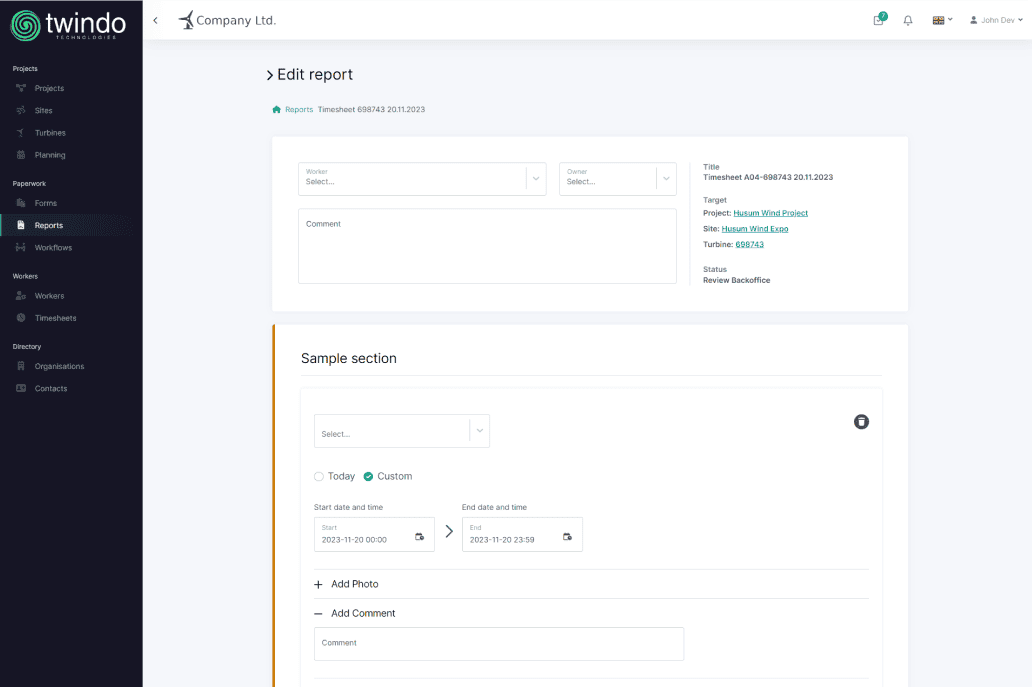Twindo is at the epicenter of the wind energy project management revolution, a concept where real-world solutions are implemented into the efficient integration of innovative technology. While adopting React-based interfaces and integrating a strong Symfony back-end, Twindo addresses the issues of project planning, implementation, and security along with the concern for improving users’ engagement and decision-making based on AI.
Consider the possibility of using a tool that not only allows for smooth and efficient planning and organizing of your projects but also makes your team members capable of accessing live and future data. Twindo does exactly this; it means that every decision made, right from resource utilization to safety measures all guided and done in such a manner that increases the chance of success. Regardless of whether you are a project manager or a field technician, Twindo clears up the confusion that comes with wind energy projects, freeing up your time to manage the projects and achieve the goals in terms of safety and efficiency.
Twindo’s goal is to improve the competencies of teams through timely availability of vital data, so workers have everything to do their work effectively and avoid hazards. This decreases the occurrence of information asymmetry, relieves management burdens, and allows for the execution of tasks with certainty and high quality. The approach of the platform to digitalization, automatization, and archiving also contributes to optimization as it eliminates paper reports and manual submission/receipt of data.
Customer engagement is also among the competing strengths that Twindo can boast of. Another significant advantage is the orientation of new and repeat customers, which is not common in this industry. It enables individuals to forward project and team data with ease thereby cutting down on time wasted and confusion that would otherwise have arisen. Being an application that was designed to allow for the sharing of information and payments quickly, Twindo enhances communication and approval processes in the wind energy industry.
Reporting of incidents is also fast, which is an important safety factor that Twindo has incorporated. The platform provides the tools and information needed to respond to incidents efficiently regardless of the workers’ location, therefore ensuring a safe environment at the workplace. Advanced features of worker profiles for Twindo, which is designed for the wind energy sector, include the tracking of certifications, training, and administration, allowing the workers to manage their profiles independently and minimize paperwork.
The Twindo tool utilizes data as a competitive advantage and delivers parameters immediately without having to extract the information from various systems, as was done before. In this sense, having access to analytics, at first sight, helps teams make better predictions and make data a weapon. Hence, Twindo’s integration with other platforms and APIs strengthens its position as a unification layer as it enables the integration of preferred solutions within a single platform without the need for multiple interfaces.
Twindo helps to address the issue of sharing historical data and the project’s experience—a distinctive characteristic of wind projects. The platform allows for easy role execution, especially through delivering on past projects where documentation does not have to be searched for, or the brain ransacked, to recall what was done. Another factor that sets Twindo apart is the use of artificial intelligence in risk minimization during project planning; this is especially important in areas of many variable factors such as availability of human resources and weather. Automation in tasks and weather forecasts makes identification capability of machine learning in identifying the tasks that are suitable to be automated and the weather that is likely to affect the project, thus minimizing guesswork and consequently, the risk that may arise.
Twindo is the ideal solution for enhancing organizational work and improving reliability in the management of wind energy projects.












